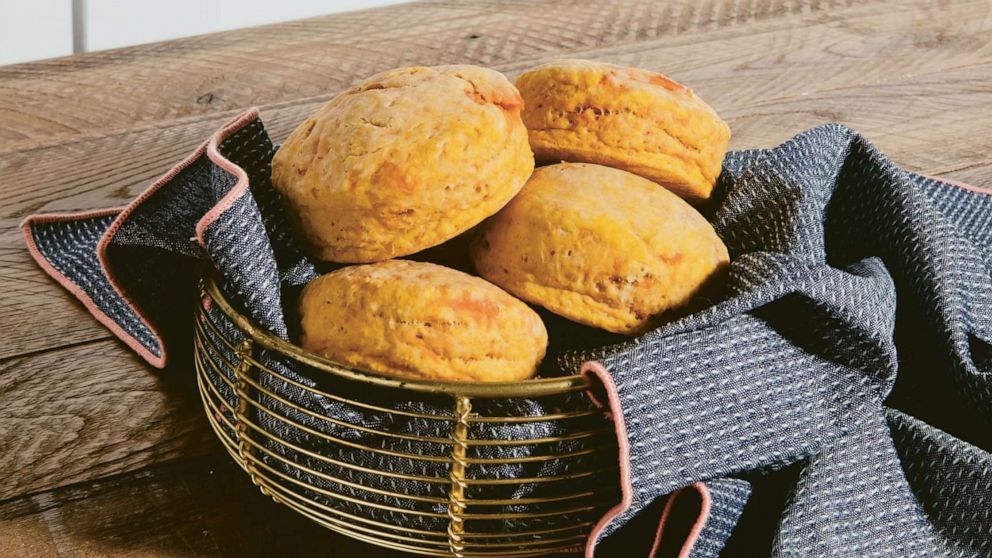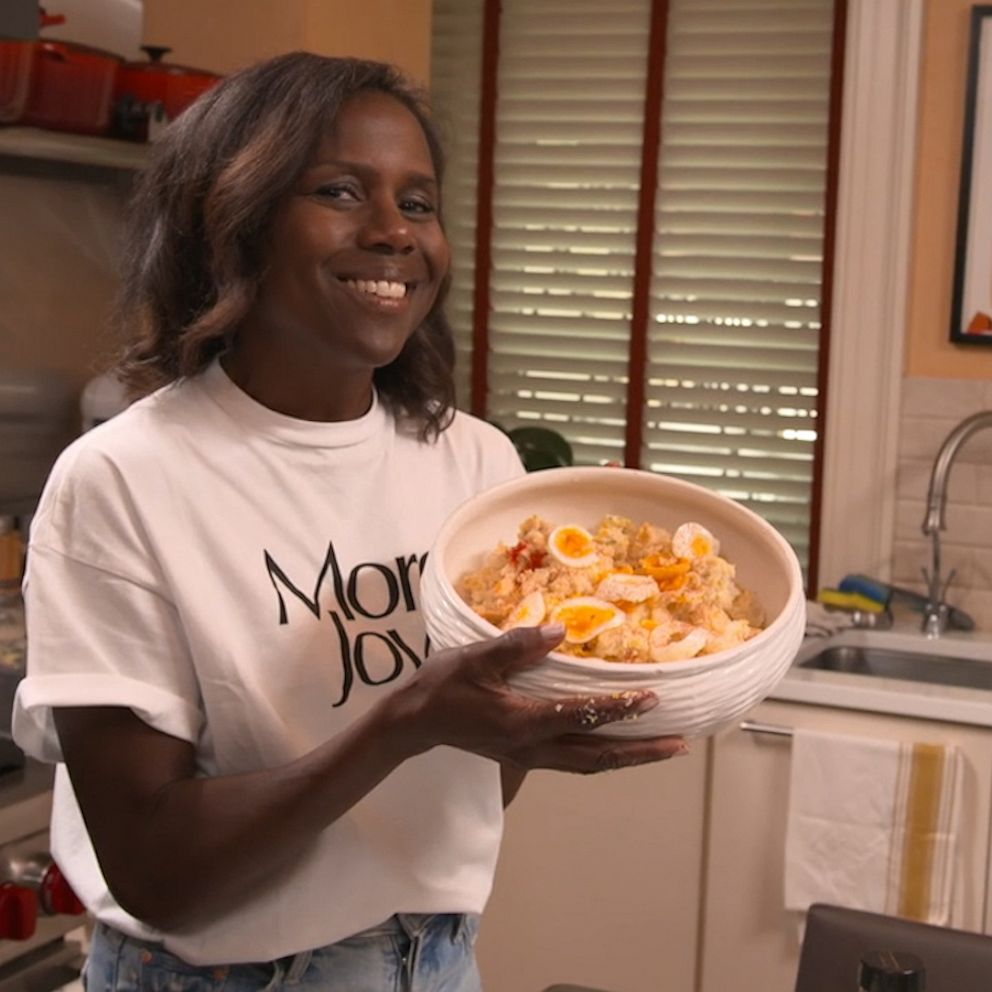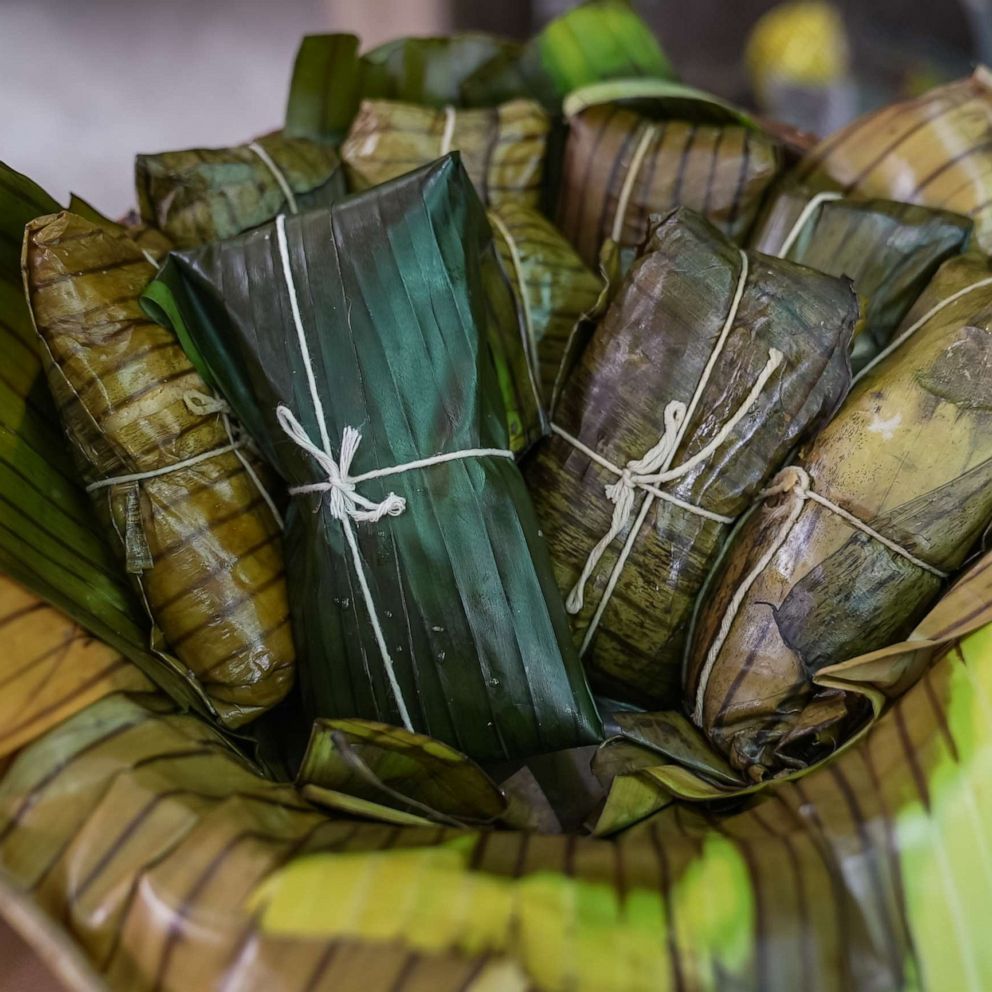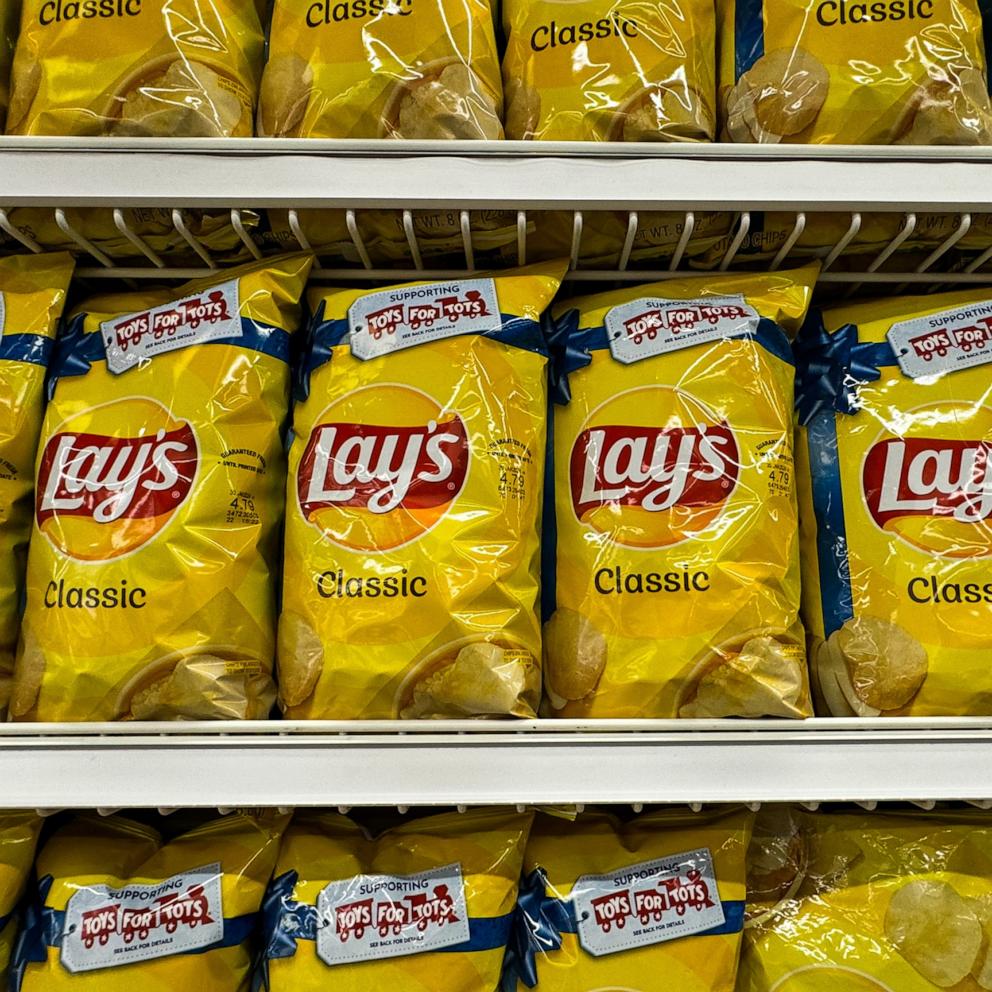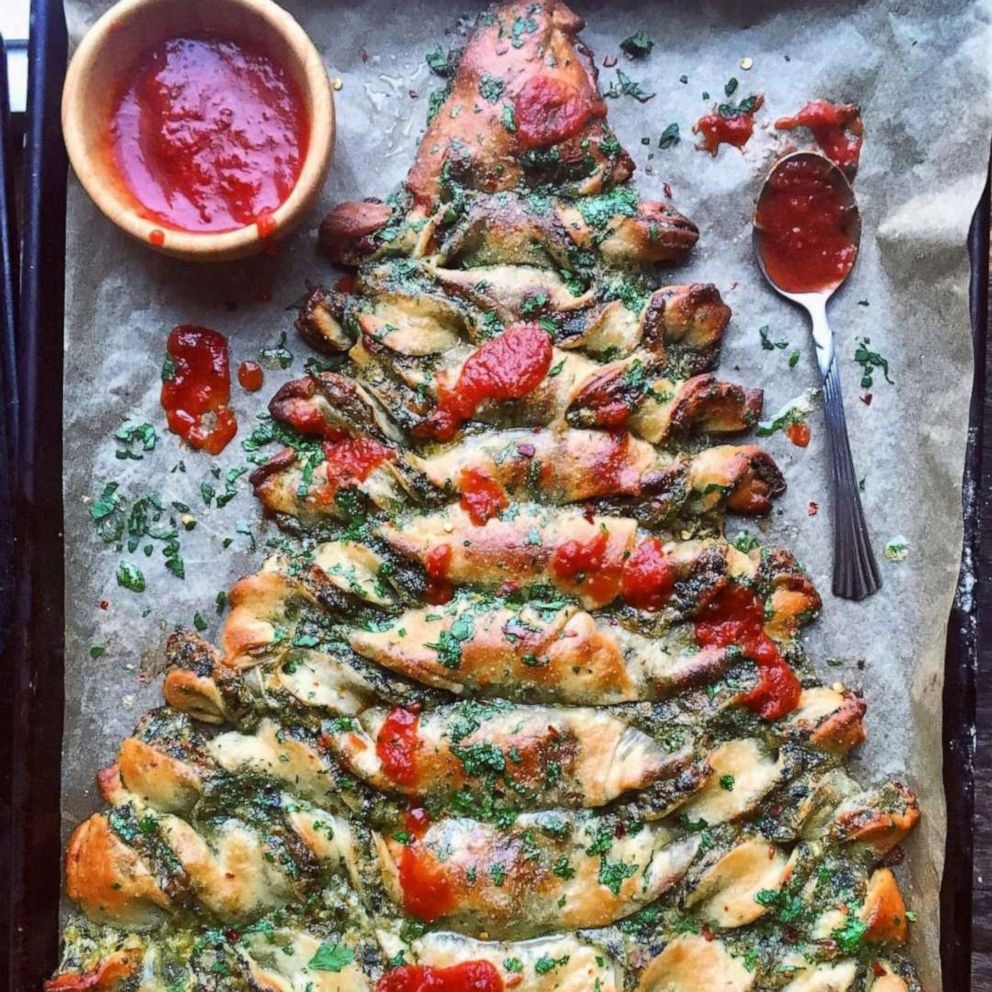Make this vegan sweet potato coconut biscuit recipe and more from Bryant Terry's 'Black Food' cookbook
James Beard Award-winning chef, educator and cookbook author Bryant Terry joined "Good Morning America" Thursday to share a recipe from his new book, "Black Food: Stories, Art, and Recipes from Across the African Diaspora."
The book, which features all vegan recipes, focuses on how Black food and history have shaped culture in America and globally.
Read on for recipes for his crunchy bean and okra fritters with mango-habanero hot sauce, vegan sweet potato coconut biscuits and slow-cooked mustard greens.

Recipe for vegan sweet potato coconut biscuits by Erika Council

Makes 8 to 10 biscuits
"In late summer our work might be thinning the long vines off the sweet potatoes because my father would say we’d only have little stringy potatoes if we didn't." -- From Mama Dip’s Kitchen by Mildred Council
Mildred Edna Cotton Council founded Mama Dip’s Restaurant in 1977. She was the daughter of a sharecropper, the granddaughter of a slave, and the founder of a culinary empire. She was also my grandmother. One of her most popular dishes was her sweet potato biscuits. I’ve adapted her recipe to make it vegan. Coconut milk adds a delicate richness, with cinnamon and brown sugar providing an extra hint of spice that elevates these biscuits to another level.
Ingredients:
2 cups all-purpose flour
1 tablespoon baking powder
2 tablespoons brown sugar
1⁄2 teaspoon kosher salt
1⁄4 teaspoon ground nutmeg
1⁄2 teaspoon cinnamon
1 cup mashed sweet potato, chilled (from about 1 large sweet potato)
1⁄4 cup chilled coconut milk, plus more as needed
Directions:
Preheat the oven to 400°F. Line a large baking sheet with parchment paper and set it aside.
In a large bowl, whisk together the flour, baking powder, brown sugar, salt, nutmeg, and cinnamon.
In a small bowl, whisk together the chilled sweet potato and coconut milk. Add this mixture to the large bowl and mix just until the dough comes together.
Turn out the dough onto a floured surface and press together with the heel of your hands. If the dough is not holding together, add in additional coconut milk one tablespoon at a time—I usually need to add about 2 tablespoons.
Turn the dough out onto a well-floured surface. With floured hands, bring the dough together, then pat it into a rectangle that is about 1 inch thick.
Cut the dough into rounds, using a 2-inch biscuit cutter. Place the biscuit rounds about 1 inch apart on the prepared baking sheet. Brush the tops of the biscuits with coconut milk.
Bake the biscuits for 12 to 15 minutes, until they are puffed and just barely golden.
Reprinted with permission from "BLACK FOOD: Stories, Art, and Recipes from Across the African Diaspora" edited by Bryant Terry, copyright© 2021. Published by 4 Color Books, an imprint of Ten Speed Press and Penguin Random House. Photographs copyright © 2021 Oriana Koren.
Recipe for slow-cooked mustard greens
"This is probably my favorite recipe in this book. I was so proud of myself for transforming a mundane side dish, braised greens, into a complexly flavored and delicious standout. Inspired by smoor tomatoes and onions—a traditional South African dish eaten as a sauce, relish, or side—I caramelize onions, then sauté them with tomato paste. I top slow-braised mustard greens with this mixture and finish it with minced jalapeños and hot-pepper vinegar. Warm, savory, and tangy sweet, this dish is everything a side of greens in pot likker should be."
Yields 4 to 6 servings
Ingredients for the greens:
1 tablespoon plus 1⁄2 teaspoon coarse sea salt
1 pound mustard greens, stems and leaves chopped separately
1 tablespoon extra-virgin olive oil
1 large clove garlic, minced
4 cups vegetable stock, homemade or store-bought
Ingredients for the onions:
3 tablespoons extra- virgin olive oil
3 large yellow onions, sliced into thin rings
2 teaspoons raw cane sugar
6 tablespoons tomato paste
1 tablespoon water
1 jalapeño chile, seeded and minced
Hot-pepper vinegar, homemade or store-bought, for serving
Directions:
To prepare the greens, put about 12 cups of water in a large pot and bring to a boil over high heat. Add the 1 tablespoon of the salt, then add the greens and their stems and cook uncovered until soft, about 5 minutes. Drain well.
Warm the oil in a large sauté pan over medium heat. Add the garlic and the remaining 1/2 teaspoon salt and sauté until the garlic is fragrant, about 3 minutes. Stir in the greens and stock, increase the heat to high, and bring to a boil. Decrease the heat to low, cover, and simmer until meltingly tender, about 45 minutes
Meanwhile, prepare the onions. Warm the oil in a separate large sauté pan over medium-low heat. Add the onions and sugar and sauté until deep golden brown and quite soft, about 15 minutes. Stir in the tomato paste and water and cook, stirring often, until the onions are thoroughly coated and hot, about 3 minutes.
To serve, portion the greens along with some of their liquid into small bowls. Top with the onions, sprinkle with the jalapeño, and drizzle some hot-pepper vinegar on top.
Recipe for crunchy bean and okra fritters with mango-habanero hot sauce
Yield 4 to 6 servings
Ingredients:
1 cup dried black-eyed peas, sorted and soaked in water overnight
1 cup skinless raw peanuts
1⁄2 red onion, finely chopped
11⁄2 teaspoons fine sea salt
1⁄4 teaspoon cayenne pepper
1⁄4 cup plus 2 tablespoons water
1 tablespoon apple cider vinegar
1 tablespoon cornmeal
1 tablespoon minced fresh thyme
1⁄2 cup sliced okra, cut paper-thin
Coconut oil, for deep-frying (about 4 cups)
Mango-habanero hot sauce (below), for serving
"I just can’t resist reinventing these tasty bites known as akara in Nigeria, acarajé in Brazil, and various other names throughout West and Central Africa and parts of the Caribbean, such as accra, akla, bean balls, bean fritters, binch akara, koose, koosé, kosai, kose, and kwasi. While I don’t deep-fry often, I certainly don’t avoid the cooking method altogether. In the context of a healthful diet, a deep-fried treat every now and then won’t do much harm. In 'The Africa Cookbook,' Jessica B. Harris explains, 'Frying in deep oil, a traditional West African cooking technique, is one of the hallmarks of the food of the African-Atlantic world.' I certainly appreciate the deep, rich flavor that it imparts.
Although bean fritters are often eaten as a breakfast item in Nigeria, they mostly show up as street food and snacks. I treat them as an appetizer here, to be enjoyed with sweet, creamy, and spicy Mango-Habanero Hot Sauce. However, you could certainly eat them as an entrée, with rice and vegetables alongside. The trick to making delicious, smooth fritters is removing the skins from all the black-eyed peas. Although this is time-consuming, it’s worth the effort; try thinking of it as cooking meditation. It’s a great party food, and I usually have one or two people help me with this task to speed things along. Traditionally, bean fritters are fried in palm oil, but I use coconut oil instead. If okra doesn’t work for you, feel free to omit it."
Directions:
Drain the black-eyed peas and rinse them well. Put them in a large bowl of water and vigorously rub them together, removing the skins as they float to the surface of the water. If the skins don’t come off easily, peel or pop them off one by one. Drain well.
In a food processor fitted with the metal blade, combine the black-eyed peas, peanuts, onion, salt, cayenne, water, and vinegar. Pulse to make a completely smooth batter, scraping down the sides if necessary. Transfer to a bowl, cover, and refrigerate for at least 1 hour and up to 1 day.
Remove the batter from the refrigerator. Add the cornmeal and thyme and beat with a wooden spoon for 2 minutes. Stir in the okra.
Warm 3 to 4 inches of oil in a small saucepan over medium-high heat until hot but not smoking, about 375°F.
Preheat the oven to 250°F. Line a plate with paper towels.
Scoop out a heaping tablespoon of batter and roll it into a walnut-size ball with your hands. Using a heatproof spoon, gently lower it into the oil. Fry fritters 4 at a time, stirring after 2 minutes, until golden brown, 4 to 5 minutes. If necessary, adjust the temperature to ensure that the fritters don’t cook too quickly.
Using a slotted spoon, transfer the fritters to the lined plate to drain briefly, then transfer them to a baking sheet and keep warm in the oven until all have been cooked. Arrange the fritters on a plat- ter and accompany with the hot sauce.
Recipe for the mango-habanero hot sauce
Ingredients:
2 teaspoons peanut oil
1⁄2 cup finely diced yellow onion
1⁄4 cup thinly sliced carrot
1 teaspoon cumin seeds, toasted and ground
3⁄4 teaspoon coarse sea salt
1⁄8 teaspoon cayenne pepper
2 large cloves garlic, minced
1⁄4 to 1 habanero chile, minced
1⁄2 teaspoon finely grated lime zest
1⁄2 cup diced ripe mango
1⁄4 cup water
3 tablespoons champagne vinegar
2 tablespoons freshly squeezed lime juice
1⁄4 teaspoon freshly ground white pepper
1⁄2 teaspoon minced flat- leaf parsley
"This thick condiment provides a nice balance of sweet, savory, and spicy. The flavor is fantastic, and the combination of habanero, mango, and carrot gives the sauce a striking color. Although I made it specifically for Crunchy Bean and Okra Fritters, it would go well with all types of foods, from breakfast burritos to roasted russet potatoes. In the instructions I suggest adjusting the amount of habanero chile depending on the amount of heat you want. For even less heat, remove the seeds and veins before mincing the habanero (it’s a good idea to wear gloves to do this). Even if the sauce is quite hot initially, I find that it tends to mellow after a few days."
Directions:
Warm the oil in a small saucepan over medium-low heat. Add the onion, carrot, cumin, salt, and cayenne and sauté until the onion just starts to brown, 8 to 10 minutes. Add the garlic, chile, and lime zest and sauté until the garlic is fragrant, 2 to 3 minutes. Add the mango, water, vinegar, lime juice, and white pepper and sauté until everything is warmed through, 2 to 3 minutes.
Transfer to a blender and puree until smooth. Taste and season with more salt if desired. Stir in the parsley. Use immediately or store in a tightly sealed jar in the refrigerator for up to 1 week.
Reprinted with permission from Afro-Vegan by Bryant Terry, copyright (c) 2014. Published by Ten Speed Press, a division of Penguin Random House, Inc. Photography (c) 2014 by Paige Green.
